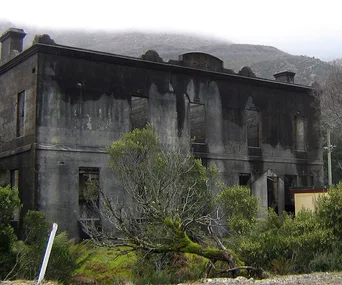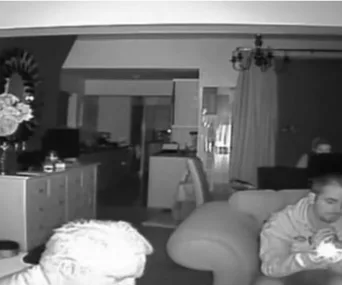Once home to miners and farmers alike, these towns collapsed along with their industries, leaving nothing but crumbling infrastructure and time-worn cemeteries.
From the depths of Tasmania to the vast outback of Western Australia, their antiquity remains frozen in time, becoming strange tourist attractions for those wanting a glimpse of the past.
Here are our pick of the 10 eeriest Aussie ghost towns to discover and explore.
Kuridala, QLD

Elevated view of the small town of Kuridala, c.1921. (Image: The Queenslander/Wikimedia)
Once a town with a strong copper mining history, all that can be seen in Kuridala today are the dilapidated remnants of a smelter and graves within neglected cemeteries. The town was previously named Gulatten, however anti-German sentiment during the war prompted the change to Kuridala, an Aborignal word meaning eagle hawk.
The town’s demise coincided with the collapse of copper prices in 1920. The major buildings in the town were abolished and by 1960 the once bustling train line ceased to exist. A population of around 1500 in 1913, by 2006 it was home to merely 209, and was not recorded in the most recent census.
Walhalla, VIC

Crowds in the once-bustling town of Walhalla, c.1910. (Image: W Lee/Wikimedia)
At its peak Walhalla was home to almost 4000 residents, today is home to less than 20. Founded as a gold mining community in 1862, the town is located in the eastern Victoria region of Gippsland.
In 1910 a railway line was built in the hope of attracting more visitors, however along with the decline of gold mining, local industry and business collapsed. Ramshackle buildings still stand in the town’s centre, drawing a large number of visitors to Walhalla throughout the year. The old mines and underground machinery chambers that lie 300 metres below the surface are a popular tourist attraction.
Poimena, TAS
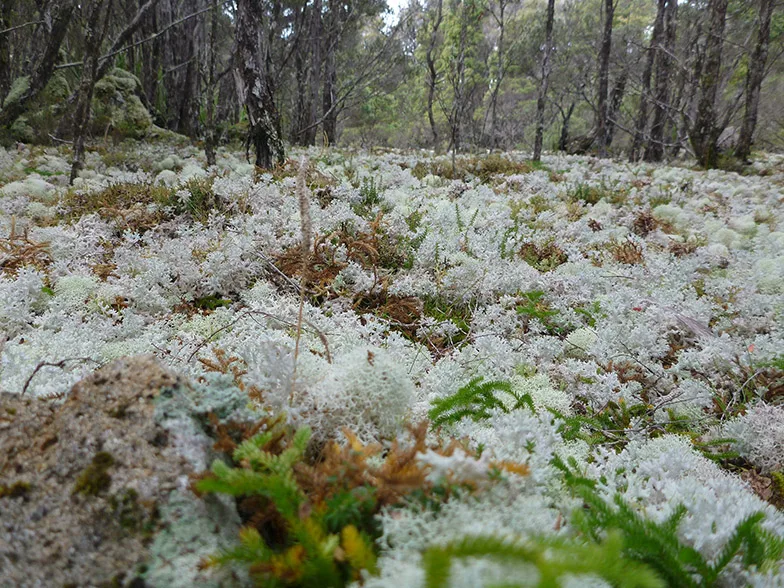
Lichen field where Poimena once stood on Blue Tier Plateau, Tasmania. (Image: Doug Beckers/Tasmania)
Poimena was once a part of several bustling towns in Tasmania’s Blue Tier Plateau. Between 1876 and 1968, the town was home to the many tin miners working in the area. Not only did it boast 3000 residents, but also three hotels, three shops, a school, blacksmith’s and a butcher. Today, Poimena is nothing more than open plain and green grassland. It has become the starting point for many beautiful bush walks and trails in the region.
Cook, SA
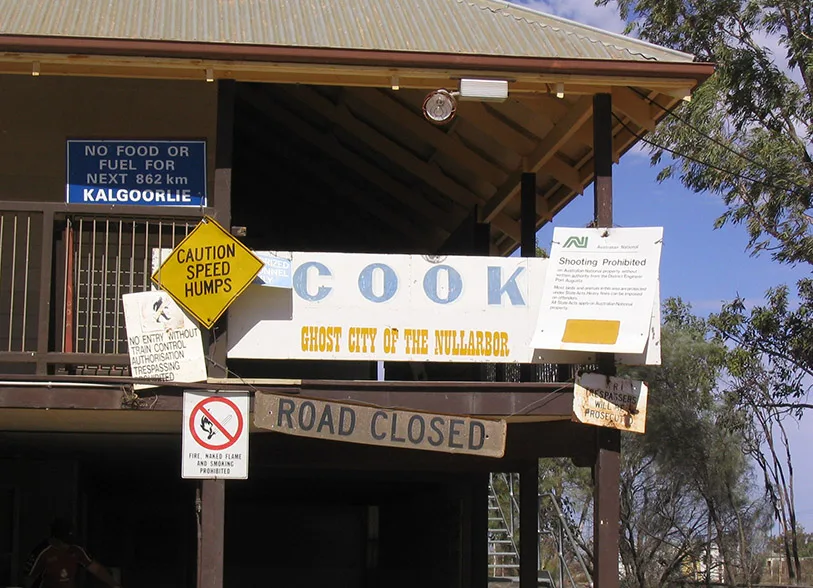
Disused building in the self-proclaimed ghost town of Cook, South Australia. (Image: John Darrington/Wikimedia)
Connected to Eyre Highway by 100km of dirt road, Cook’s current population can be counted on one hand. The town was established in 1917 along with the Trans-Australian Railway, the longest stretch of straight railway in the world.
Cook was once home to a bush hospital which advertised itself with a sign at the station saying, “If you’re crook, come to Cook.” Previously relying on an underground artesian aquifer, the town’s water supply is now carried in by train. It has become a pit-stop for those travelling in luxury on the Indian-Pacific, where passengers can alight and wander through.
Kathleen, WA
Located between Leinster and Wiluna along the Goldfields Highway in Western Australia, Kathleen was previously a small gold mining town that had a general store, butcher and two hotels. The settlement was known as Kathleen Valley, until 1900 when it was gazetted and the “valley” was dropped (it is not known who ‘Kathleen’ was). After gold in the area had dried up, the town was abandoned. Today, all that remains are eight graves in a damaged old cemetery.
Silverton, NSW

Old railway platform for the defunct Silverton Tramway. (Image: Conollyb/Wikimedia)
The small village town of Silverton was once a silver-ore mining hub and home to around 3000 people. It wasn’t until 1875, when two men drilling a well on a station just south of the area hit a deposit of silver, that the town was officially established some 10 years later. But it was with the discovery of an even richer ore body in Broken Hill that led to the abandonment of the town.
Today it has a permanent population of around 50 people. The Silverton Hotel remains standing and has been featured in a number of Australian film production such as Mad Max 2, The Adventures of Priscilla, Queen of the Desert and Razorback.
Pillinger, TAS
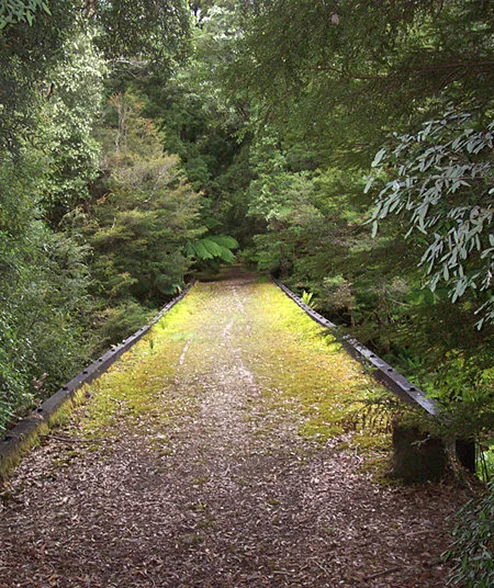
A railway bridge leading to East Pillinger. (Image: Joanne Powell / Wikimedia)
Once a busy port in the Kelly Basin, Pillinger has now been reclaimed by forest. The town was established so that the North Mount Lyell Company could ship ore from the town of Crotty to Pillinger. There were once three wharves, a saw mill, brickworks and a shipping terminus, however today most of what’s left is decaying fragments of the rail line.
The town’s last permanent residents left some 70 years ago. Visitors can still reach ruins at East Pillinger by a four-hour return walk along the railway and river, which starts at Kelly Basin Road, south of Lynchford.
Shay Gap, WA
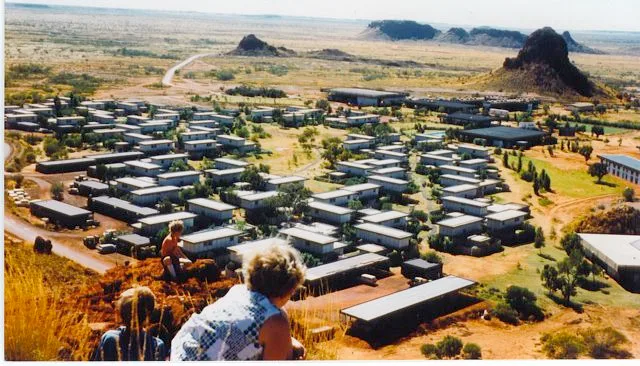
Overlooking Shay Gap in 1975. (Image: Micwhitty/Wikimedia)
Located 188km east of Port Hedland and 68km north-east of Marble Bay, Shay Gap is burrowed amongst rugged and rocky ranges. In the mid-1990s, the town was home to nearly 1000 people, but today it ceases to exist.
Shay Gap was once a company town developed by Mount Goldsworthy Mining associates. When mining activities stopped, buildings and houses were sold, demolished or relocated to the nearby town of Yarrie, leaving nothing but the faint outline the long-gone structures.
Arltunga, NT
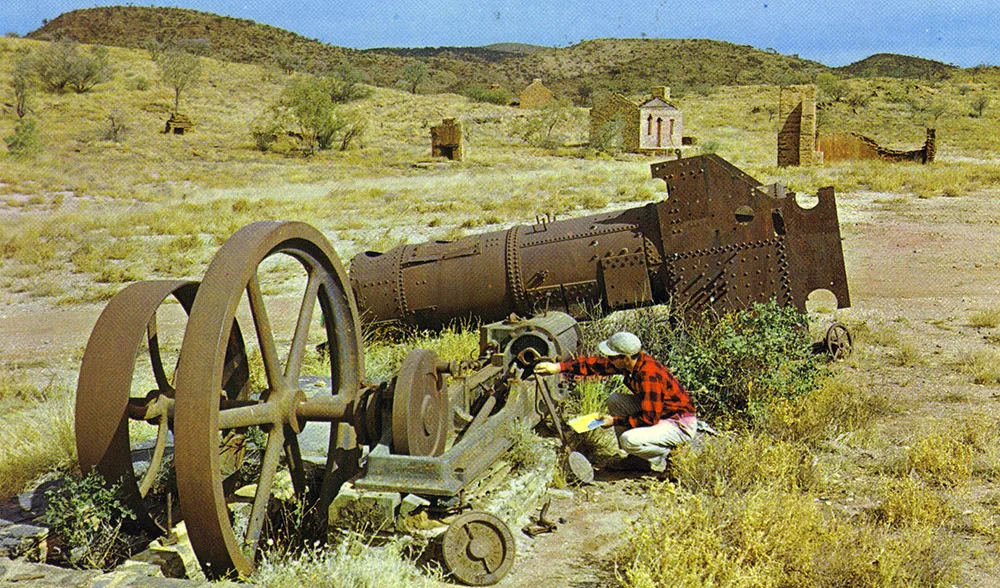
Ruins at Arltunga in the Northern Territory. (Image: Gawler History/Flickr)
Central Australia’s first official town is located 110km east of Alice Springs and 1610km from Darwin. During the 1880s it was only accessible by walking or riding alongside the Overland Telegraph Line from Oodnadatta to Alice Springs, then following the MacDonnell Ranges east. Once home to 300 residents, today there are merely the relics of an old police station and goal. The dryness in the area, however, has managed to preserve many interesting artefacts such as tin cans, bottles and parts of houses.
Farina, SA

Headstones inscribed with Arabic and facing Mecca in Farina, South Australia. (Image: HSpirit/Wikimedia)
With a population of 600 by the late 1800s, Farina was once a buzzing town that had two hotels, an underground bakery, a bank, two breweries, a general store, a church and even a brothel. But by the 1930s, drought claimed the town and, along with the water, began to empty. The cemetery can still be seen today, with one corner of it containing headstones inscribed with Arabic, marking the resting place of former residents who worked on the Afghan camel trains. Volunteer efforts are currently under way in the hope of restoring this historically fascinating town.
This story originally appeared on Australian Geographic. It is an edited and extended version of the Six of the best ghost towns story from 2010.

